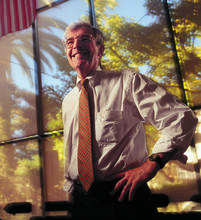Our Founder
The visionary leader behind Leidos
In 1969 Dr. J. Robert Beyster led a happy, comfortable life as a nuclear physicist in San Diego. He was 45 and married with three young children. In other words, it probably wasn't the perfect time to start his own company, but that's exactly what he did.
Dr. Beyster may never have envisioned that his startup would one day become a $10 billion Fortune 500 company, but here we are. The story of today’s Leidos started in 1924 when Beyster was born in Detroit. He was raised in nearby Grosse Ile, Mich., where he learned about hard work and commitment as he watched his family persevere through the Great Depression.
Beyster enlisted in the Navy after graduating from high school, and was enrolled in the V-12 Office Training Program. He was commissioned as an ensign, and served on a destroyer during World War II. With the help of the G.I. Bill, Beyster attended the University of Michigan after his naval career and earned several degrees, including his PhD in nuclear physics in 1950.
After earning his doctorate, Beyster worked briefly for Westinghouse Atomic Power Division on the company's nuclear submarine program. He then joined Los Alamos National Laboratory as a research physicist for five years before spending a dozen years with General Atomics in San Diego as the chair of the Accelerator Physics Department. His time there came to an end shortly after Gulf Oil acquired General Atomics. Beyster felt that senior management had little interest in the research his department was performing. What came next was a leap of faith that changed his life and the lives of countless others.
SAI is born
From the outset, Beyster knew he wanted to create a company built around employee ownership that encouraged a culture of entrepreneurship. Beyster said making money was never the motivation for his startup. Instead, he simply wanted to “perform research in a productive environment” alongside talented scientists and engineers on issues of national importance.
Beyster began the process of launching his company by cashing out some of his General Atomics stock in 1968. He didn’t create a fancy business plan either, opting instead for a handwritten “organizational plan.” Along with a few associates, he settled on Science Applications Incorporated (SAI) as the name of the new venture – a name that encompassed the business without being grandiose.
SAI was officially launched on Feb. 3, 1969. Beyster invested $50,000 of his own money and secured a bank loan using his home as collateral to set up offices in La Jolla, Calif. That investment helped Beyster pay the salaries of his first employees while he deferred his own salary for the first year.
He made it a priority to ensure that every employee owned a part of the new company, even using employee ownership as a recruitment and retention tool. Staff were expected to perform superior scientific and technical work while also playing a key role in the management and direction of the company. In fact, the company’s brightest minds served as SAI’s frontline marketing and sales staff.
According to Dr. Beyster’s daughter Mary Ann, “It was learned fairly quickly that every person had a role in growing the business and making the business profitable.”
A lasting legacy
Under the leadership of Dr. Beyster, SAI grew rapidly in both stature and value, eventually changing its name to Science Applications International Corporation (SAIC) in 1984 [the company didn’t become Leidos until 2013]. Beyster retired as SAIC’s chairman in 2004, capping off a remarkable 35 years with the company. In the years since, Leidos continues to build on Beyster’s original vision to develop scientific solutions that impact the country and our world.
In 1997, Forbes published a cover story on Dr. Beyster and the rise of SAIC, focusing on the company’s spread-the-wealth management style. Beyster’s stock was worth about $27 million at the time but could have been worth about $2 billion if he had maintained all of it rather than sharing it with employees. Instead, the company made millionaires out of hundreds of its workers. Beyster had no regrets about his advocacy of employee ownership, once writing that “External, disinterested individuals who would own part of the company and contribute little do not deserve to benefit by the hard work of the individuals within the company.”
Dr. Beyster was also passionate about sharing his employee ownership beliefs within the business community. He founded two nonprofits, the Beyster Institute and the Foundation for Enterprise Development, and helped establish the J. Robert Beyster Fellowship and Professorship for Rutgers University’s School of Management and Labor Relations. Beyster also wrote a book about his legendary career, The SAIC Solution: How We Built an $8 Billion Employee-Owned Technology Company.
Philanthropic work was a big part of Dr. Beyster’s life as well. He and his wife Betty supported numerous education, environment, arts and culture, and health services organizations. Their generosity included a $15 million donation to the University of Michigan’s College of Engineering and $8 million to build a new nursing center at the University of San Diego.
Dr. Beyster passed away in 2014 but his legacy endures. Many of the names and faces have changed over the course of 50 years, but Beyster’s still carries weight. Mark Sopp, former chief financial officer of SAIC, sums it up best: “There’s a piece of Bob Beyster in both SAIC and Leidos many years later that is still an important part of the mission, the culture, and the history.”


